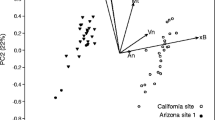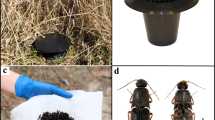Abstract
Analyses of the enantiomeric composition of ipsdienol produced by individual male pine engravers,Ips pini (Say), from six populations in British Columbia, support the hypothesis that New York and Idaho races of this species hybridize in southeastern British Columbia. Production profiles, expressed as frequency distributions of (+):(-) ipsdienol ratios [= ratio of (S)-(+)-ipsdienol to (R)-(-)-ipsdienol], were bimodal for four western British Columbia populations. The (+):(-) ratios ranged from 63:37 to 71:29. consistent with those previously found for the New York race. The profile for a southeastern population from Radium, British Columbia, was intermediate between those for the four western British Columbia populations and that from one population in Kimberley, British Columbia, just south of Radium. Males in the Kimberley population produce predominantly (R)-(-)-ipsdienol, typical of California nad Idaho males. Response profiles of different individuals ofI. pini, determined by captures of beetles in multiple-funnel traps baited with ipsdienol of 11 different (+):(-) ratios, were not consistent with production profiles. Populations in Williams Lake and Princeton, in western British Columbia, and Radium, in southeastern British Columbia, had response profiles with maximal attraction to ipsdienol over a broad range of (+):(-) ratios, falling off as enantiomeric purity was approached at either end of the spectrum. This type of response profile is consistent with that for the New York race, which has been shown to respond optimally to (+):(-) ratios ranging from 40:60 to 70:30. The response profile of the Kimberley population gradually declined from maximal attraction to ipsdienol with a (+):(-) ratio of 2:98 to the lowest response at a (+):(-) ratio of 98:2. The attraction ofI. pini to chemical stimuli in California is interrupted by ipsdienol with a (+):(-) ratio >5:95, a pheromone of a host competitor, the California five-spined ips,Ips paraconfusus Lanier. We hypothesie that the Idaho race, which does not compete withI. paraconfusus due to geographical separation, is characterized by a Kimberley-type enantiomeric response profile, intermediate between those of the New York and California races.
Similar content being viewed by others
References
Anglade, P., Stockel, P., andIWGO Cooperators. 1984. Intraspecific sex-pheromone variability in the European corn borer,Ostrinia nubilalis Hbn. (Lepidoptera, Pyralidae).Agronomie 4:183–187.
Barbattini, R., Marchetti, S., Pravisani, L., andZandigiacomo, P. 1985. Attrazione di feromoni sessuali di sentes nei confrontiOstrinia nubilalis Hb. in Fruili.Frustula Entomol. 7:1–21.
Birch, M. C. 1978. Chemical communication in pine bark beetles.Am. Sci. 66:409–419.
Birch, M. C., Light, D. M., Wood, D. L., Browne, L. E., Silverstein, R. M., Bergot, B. J., Ohloff, G., West, J. R., andYoung, J. C. 1980. Pheromonal attraction and allomonal interruption ofIps pini in California by the two enantiomers of ipsdienol.J. Chem. Ecol. 6:703–717.
Borden, J. H. 1967. Factors influencing the response ofIps confusus (Coleoptera: Scolytidae) to male attractant.Can. Entomol. 99:1164–1193.
Cardé, R. T. 1986. The role of pheromones in reproductive isolation and speciation of insects, pp. 303–317,in M.D. Huettel (ed.). Evolutionary Genetics of Invertebrate Behavior. Progress and Prospects, Plenu, New York.
Cardé, R. T., Baker, T. C., andRoelofs, W. L. 1976. Sex attractant response of male Oriental fruit months to a range of component ratios: Pheromone polymorphism?Experientia 32:1046–1047.
Klun, J. A., andCooperators. 1975. Insect sex pheromones: intraspecific pheromonal variability ofOstrinia nubilalis in North America nad Europe.Environ. Entomol. 4:891–894.
Klun, J. A., andHuettel, M. D. 1988. Genetic regulation of sex pheromone production and response: Interaction of sympatric pheromonal races of the European corn borer.Ostrinia nubilalis (Lepidoptera: Pyralidae).J. Chem. Ecol. 14:2047–2061.
Kochansky, J., Cardé, R. T., Liebherr, J., andRoelofs, W. L. 1975. Sex pheromone of the European corn borer,Ostrinia nubilalis (Lepidoptera: Pyralidae), in New York.J. Chem. Ecol. 1:225–231.
Lanier, G. N., Classon, A., Stewart, T., Piston, J. J., andSilverstein, R. M. 1980.Ips pini: The basis for interpopulational differences in pheromone biology.J. Chem. Ecol. 6:677–687.
Light, D. M., andBirch, M. C. 1977. Inhibition of the attractive pheromone response ofIps paraconfusus by (R)-(-)-ipsdienol.Naturwissenschaften 66:159–160.
Light, D. M., Birch, M. C., andPaine, T. D. 1983. Laboratory study of intraspecific and interspecific competition within and between two sympatric bark beetle species.Ips pini andI. paraconfusus.J. Appl. Entomol. 96:233–241.
Lindgren, B. S. 1983. A multiple-funnel trap for scolytid beetles.Can. Entomol. 115:299–302.
Löfstedt, C. 1990. Population variation and genetic control of pheromone communication systems in moths.Entomol. Exp. Appl. 54:199–218.
Miller, D. R., Borden, J. H., andSlessor, K. N. 1989. Inter-and intrapopulation variation of the pheromone, ipsdienol produced by male pine engravers,Ips pini (Say) (Coleoptera: Scolytidae).J. Chem. Ecol. 15:233–247.
Miller, D. R., Gibson, K. E., Raffa, K. F., Seybold, S. J., Teale, S. A., andWood, D. A. 1996. Geographic variation in the response of the pine engraver,Ips pini (Say) (Coleoptera: Scolytidae), to the pheromone, lanierone.J. Chem. Ecol. Submitted.
Peña, A., Arn, H., Buser, H. R., Rauscher, S., Bigler, F., Brunetti, R., Maini, S., andToth, M. 1988. Sex pheromone of the European corn borer,Ostrinia nubilalis: Polymorphism in various laboratory and field strains.J. Chem. Ecol. 14:1359–1366.
Plummer, E. L., Stewart, T. E., Byrne, K., Pearce, G. T., andSilverstein, R. M. 1976. Determination of the enantiomeric composition of several insect pheromone alcohols.J. Chem. Ecol. 2:307–331.
Roelofs, W. L., Du, J.-W., Tang, X.-H., Robbins, P. S., andEckenrode, C. J. 1985. Three European corn borer populations in New York based on sex pheromones and voltinism.J. Chem. Ecol. 11:829–836.
Schlyter, F., andBirgersson, G. 1989. Individual variation in bark beetle and moth pheromones—a comparison and an evolutionary background.Holarct. Ecol. 12:457–465.
Seybold, S. J. 1992. The role of chirality in the olfactory-directed aggregation behavior of pine engraver beetles in the genusIps (Coleoptera: Scolytidae). PhD thesis. University of California at Berkeley, 355 pp.
Seybold, S. J. 1993. Role of chirality in olfactory-directed behavior: Aggregation of pine engraver beetles in the genusIps (Coleoptera: Scolytidae).J. Chem. Ecol. 19:1809–1831.
Seybold, S. J., Teale, S. A., Wood, D. L., Zhang, A., Webster, F. X., Lindahl, K. Q., Jr., andKubo, I. 1992. The role of lanierone in the chemical ecology ofIps pini (Coleoptera: Scolytidae) in California.J. Chem. Ecol. 18:2305–2329.
Seybold, S. J., Ohtsuka, T., Wood, D. L., andKubo, I. 1995a. Enantiomeric composition of ipsdienol: A chemotaxonomic character for North American populations ofIps spp. in thepini subgeneric group (Coleoptera: Scolytidae).J. Chem. Ecol. 21:995–1016.
Seybold, S. J., Quilici, D. R., Tillman, J. A., Vanderwel, D., Wood, D. L., andBlomquist, G. J. 1995b.De novo biosynthesis of the aggregation pheromone components ipsenol and ipsidenol by the pine bark beetles,Ips paraconfusus Lanier andIps pini (Say) (Coleoptera; Scolytidae).Proc. Natl. Acad. Sci. U.S.A. 92:8393–8397.
Slessor, K. N., King, G. G. S., Miller, D. R., andCutforth, T. L. 1985. Determination of chirality of alcohol or latent alcohol semiochemicals in individual insects.J. Chem. Ecol. 11:1659–1667.
Stewart, T. E. 1975. Volatiles isolated fromIps pini: Isolation, identification, enantiomeric composition, biological activity, and the enantiomeric composition of other insect pheromone alcohols and bicyclic ketals. Msc thesis. State University of New York, Syracuse, 135 pp.
Teale, S. A., andLanier, G. N. 1991. Seasonal variability in response ofIps pini (Coleoptera: Scolytidae) to ipsdienol in New York.J. Chem. Ecol. 17:1145–1158.
Teale, S. A., Webster, F. X., Zhang, A., andLanier, G. N. 1991. Lanierone: A new pheromone component fromIps pini (Coleoptera: Scolytidae) in New York.J. Chem. Ecol. 17:1159–1176.
Teale, S. A., Hager, B. J., andWebster, F. X. 1994. Pheromone-based assortative mating in a bark beetle.Anim. Behav. 48:569–578.
Wood, S. L. 1982. The bark and ambrosia beetles of North and Central America (Coleoptera: Scolytidae), a taxonomic monograph.Great Basin Nat. Mem. 6, 1350 pp.
Author information
Authors and Affiliations
Rights and permissions
About this article
Cite this article
Miller, D.R., Borden, J.H. & Slessor, K.N. Enantiospecific pheromone production and response profiles for populations of pine engraver,Ips pini (Say) (Coleoptera: Scolytidae), in British Columbia. J Chem Ecol 22, 2157–2172 (1996). https://doi.org/10.1007/BF02040100
Received:
Accepted:
Issue Date:
DOI: https://doi.org/10.1007/BF02040100




